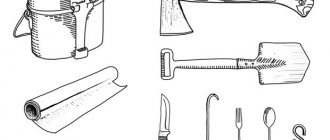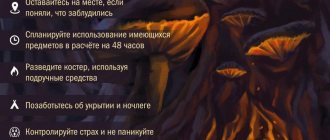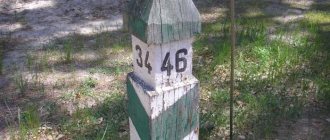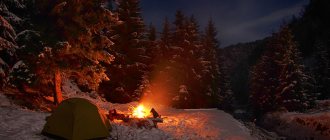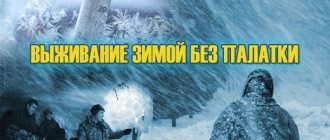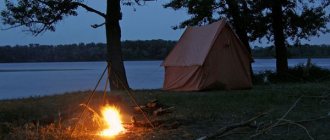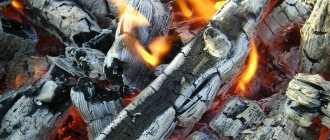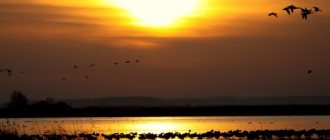During more than twenty years of hunting wanderings and overnight stays in the taiga, my main weapon was a fairly heavy and reliable ax with a wooden hatchet. Having such an ax and preparing to spend the night in the taiga, you can always prepare two stumps of dry wood 20-40 cm in diameter and 2.5-3 m long. In this case, one should be about half thinner than the other. They are laid parallel - so that the thin log is on the side of the future bed; a fire is lit between them. The fire will burn at first with a bright, even flame, and then smolder throughout the night, emitting heat that emanates towards the thin log, that is, towards the bed.
You have to adjust such a fire once or twice a night. Firewood should not spark or “shoot” strongly when burning, otherwise you can burn your camping property, and even get severe burns while sleeping. For kindling, I recommend dry birch bark, twigs split and planed with a knife, broken dry twigs (near the trunks of cedars and spruces they remain dry even in heavy rain), resinous chips of dead cedars, spruce, larch, fir, pine, as well as chips of old resinous stumps .
A finger-thick stick should be planed from top to bottom so that the chips do not break off and form a kind of plume. It is enough to make several of these plumes, stack them on top of each other, and place chopped dry twigs and wood chips over them in a hut so that the fire will light up from the first match in any weather.
In the rain in the taiga
In rain and strong winds in the taiga, the kindling should be covered by placing supports or asking a friend to hold the already wet jacket. This way you can make a fire even in a rainstorm. Tree species most suitable for a fire (in order of preference): ash, elm, elm, willow, poplar, aspen, alder, birch, cedar, pine, spruce. Fir shoots embers the most and should not be used for fires if there are other trees.
Dead wood that has been lying around for a long time is most often damp, so it is advisable to look for dry but still standing trees. A lot of dry material occurs in rubble on the banks of rivers and streams. But do not rush to put up a tent or settle down for the night on a sandy or pebble spit next to the rubble. In the mountain-taiga area, which is most of the territory of Siberia and the Far East, floods are common in summer and autumn.
The water rises several meters in just three to four hours. And at the same time, it is not at all necessary that it rains where you are: the rains can fall far in the mountains, and you will suddenly be overtaken by a flood.
A campfire for the night and a protective canopy in the taiga.
Forced overnight stay in the forest
Forced overnight stay in the forest Under these conditions, the greatest danger is hypothermia and frostbite, the occurrence of which is facilitated by low temperature, wind and moisture.
You should make sure that your clothes have tight fasteners, but do not interfere with blood circulation. Multi-layer clothing, such as gloves nested inside larger mittens, gives good results. The top layer should be windproof, or better yet, waterproof. For insulation, it is possible to lay dry grass, etc. between the layers. Particular attention should be paid to the arms and legs, since they are on the periphery of the blood supply and, therefore, frostbite is most likely there.
To prevent frostbite, it is recommended to take off your shoes and warm your feet with a friend under your armpit, etc., if you are alone, you need to move your toes. To prevent frostbite on the face, it is recommended to grimace, which helps increase blood circulation.
In case of frostbite and/or hypothermia, it is necessary to warm the victim with your body or hot water, wrap him warmly, if possible change wet clothes, give hot food and drink. You cannot: give alcoholic drinks, massage frostbitten areas, since they are easy to damage, apply snow and ice, pierce blisters, quickly warm up, especially with fire, hot stones, etc., allow the victim to walk, leaning on a relatively recently frostbitten leg. While frostbite is easy to detect, hypothermia is not always easy to recognize. It is very important to monitor for the following symptoms: pallor and severe uncontrollable trembling, abnormally low body temperature, muscle weakness and fatigue, drowsiness and weakened vision, decreased heart rate and breathing, loss of consciousness.
We must not forget that warming procedures should be carried out; in addition, if the victim does not show signs of life (in combination with artificial respiration and chest compressions), it is possible to declare that the victim has died only when resuscitation measures did not give results at normalized body temperature. It is better to sleep two in one sleeping bag for mutual warmth. If you cannot avoid spending the night, let alone living outside your home in winter conditions, you need to take care of constructing a shelter. Before this, it is necessary to analyze the number of people in the group (or alone), the presence of tools (shovel, hacksaw...), the properties of the snow (thickness of the cover, dense or loose, whether it is molded...), the presence of building materials (parachute, tarpaulin, boards, plastic...). Having assessed your capabilities, you can choose the type of shelter.
1) Trench. It makes sense to use it while alone. You need to lay something underneath to insulate from snow, so as not to get wet, for example, coniferous branches. If the snow is dense, a roof can be made by cutting slabs and laying it as a hut. If there are branches, twigs, etc., it is possible to lay them as a roof and sprinkle them with snow, especially if the snow is sticking.
2) Under a huge spruce tree. Used in the forest when there is a huge amount of snow. A depression often forms around the trunk. On one side of the spruce a fire is made, on the other side branches are laid for sleeping.
3) Cave. This type of shelter is recommended only in deep snow (at least two meters), but my experiments have demonstrated that 1 meter is enough for dozing, and 1.5 meters for cooking (you need to make an additional hole for ventilation). For the construction of a shelter, it turned out that a sapper's shovel was enough.
4) Igloo. This is done in dense snow using a hacksaw. The layers are cut and laid out in the form of a hemisphere.
5) Beehive. This is done if you have a tarpaulin, a parachute, etc. A pile of branches is thrown up and covered with a cloth, covered with snow on top. Later, the branches and cloth are carefully pulled out.
6) Like a snow fortress. This is done without any tools, you just need to let the snow stick together. For the roof you need to get branches or other similar material so that it does not collapse.
7) If it is not possible to use snow, it is necessary to look for shelter near fallen trees, which can be covered with branches for protection from the wind, or use various folds of the terrain. When building a shelter, you must try to heat it. Do not forget that the greater the amount of air inside the shelter, the more difficult it is to heat it, but in addition, a burning candle can warm a small room well. Ventilation is required!
Survival in the taiga. We are building a Taiga booth or hut. Life and accommodation. Taiga. Fishing. Hunting.
Solo hike to Vetlan. “Survival” and spending the night in a winter forest at -26 without a tent or fire. PVD
Place to spend the night in the taiga
The place directly for making a fire should be chosen in a quiet place, and the logs should be positioned so that a light breeze blows at a slight angle from the bed, then smoke and random sparks will be carried to the side, and a sufficient amount of heat will be radiated to the sleeper.
To organize an overnight stay, they use large turnings (in case of strong winds, you need to make sure that the surrounding trees will not fall on the bivouac), steep banks (not in summer), various kinds of protrusions and uneven ground surfaces, or they arrange large protective canopies from spruce branches, branches and herbs that simultaneously serve as heat reflectors onto the bed. A place to spend the night does not have to be level: sometimes, on the contrary, you should make your bed on a slight slope and lie down with your feet towards the fire.
In this case, it is prudent to place damp dead wood along the fire to prevent it from rolling onto it at night. The arrangement of the bed is also important for a good night's sleep. He repeatedly heated the ground with a large fire on the site of his future bed. In this case, two fires are lit. While dinner is being prepared on a small fire, a large one heats up the favorite place.
Then the burning logs are moved to the side, the ground is thoroughly swept, the damp perches are laid out evenly, covered with a layer of spruce branches, reeds or grass, and a cloak is spread on top.
In winter in the taiga
In winter in the taiga, the bed should be prepared especially carefully to avoid radiculitis. Usually, when going to bed by the fire, you should take off your shoes. For the autumn-winter period, it is advisable to carry fur stockings with you, which are easy to sew yourself from various kinds of old chicken products or from the skins of low-value animals. These stockings can provide an invaluable service. They helped me out on Anyui when I fell through the ice.
At temperatures below zero, the first thing you need to do is take care of your feet. Lots of fire for cooking and tea. An indispensable condition is that it must be small. It is convenient to work around such a fire, it consumes less fuel and, strange as it may seem at first glance, you can cook dinner faster on it. If you are preparing only tea, then having hammered two fliers, you can use one: hang the pot on a stick, place it on one support, and hold the stick by the other end with your hand so that the pot is in the flame.
The second flyer is hammered in only as a safety net if you suddenly need to move away from the fire. With this method, 4-5 minutes are enough - and the water boils. The most efficient type of fire for cooking is a hut.
G. Levkin.
How Ingush terrorists arrange life in the forest
A very interesting post from a representative of the Ingush special forces, who periodically participates in the fight against terrorism. I suggest you find out how the Ingush bandits - the so-called Imaratysh - arrange their life in the forest. Conditions are far from ideal - we have to adapt. But sooner or later, such camps are still discovered. Writes
If you've been hiking, you know that maintaining hygiene at all times is a challenge. Sooner or later, disgust recedes and now you take food with not very clean hands, tolerate the greasy content of the dishes, and somehow do not strive for their ideal cleanliness. If you have to constantly live in the forest, far from civilization, especially if you have to constantly hide and hide, hygiene inevitably gives way to the need to constantly fight hunger and cold. But there is one thing. The bandits are trying to somehow return people who are too zealous in their piggishness to the minimum requirements of order. If the stench can still be tolerated for the time being, then no one wants to constantly see lice, bedbugs and rotting body parts. There were even cases of execution of fallen militants. Because it is impossible to let him go in peace, and it is also impossible to re-educate him. Execute cannot be pardoned.
Living independently is difficult. The bandits are trying to create some minimum of amenities, but still, a rat’s life is a rat’s life. Well, actually, no one promised that it would be easy. And from the very beginning they warn newcomers about the hardships and hardships “in jihad.” True, in practice everything turns out to be much worse than in words. Sooner or later, “jihad warriors” stop treating life as a value, because the value of such a life objectively tends to zero. Yes, no one wants to die; the instinct of self-preservation works here too. I personally have not seen any cases when a Mujahid would rush into a crowd of enemies, sowing panic among them with his courage, as their propagandists like to tell. As a rule, during a clash, the bandits’ goal is to be as far as possible from the sound of gunfire. Well, unlike the Israelis, abandoning one of their own during a battle is not considered some kind of offense that deserves condemnation.
Bandits live in dugouts and dugouts only in winter. The rest of the time, it is impossible to live in them, because the hole needs to be heated all the time to overcome the dampness. If you don’t do this, then she will drive you to the grave faster than “evil infidels with machine guns.” It is very rarely possible to make a dugout comfortable. I saw only a couple of holes where it was possible to move at full height and where more or less comfortable conditions for wintering were created. For example, these are:
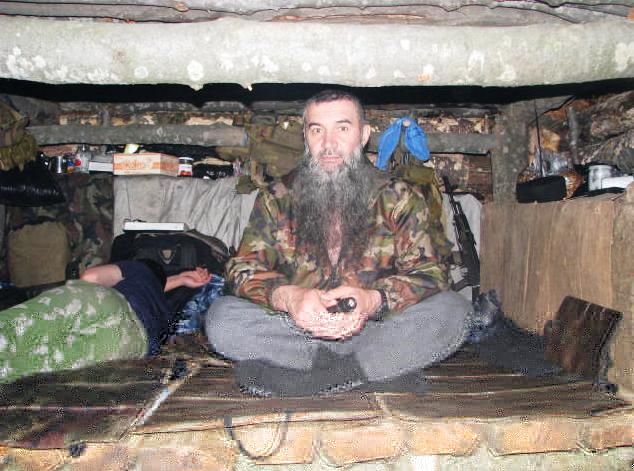
Most often they move around the dugout on all fours. I don't care about fat - I wish I could live. The stench in these holes is unbearable and soaks into everything. What to do - there is nowhere to wash in winter...
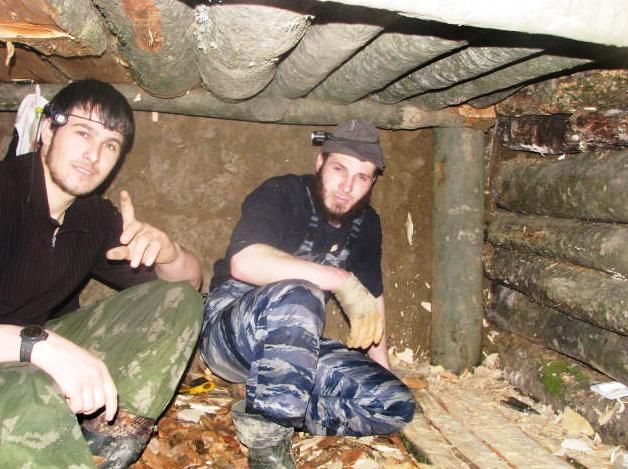
In the summer, bandits live in tents or simply sleep in the open air. This is due to the fact that the bases need to be preserved for wintering. The loss of a base on which a lot of effort was spent is a tragedy. Especially in winter, when it is very difficult to build even a temporary dugout. Crying, a terrorist, “evil infidels and apostates” found and burned his native hut:
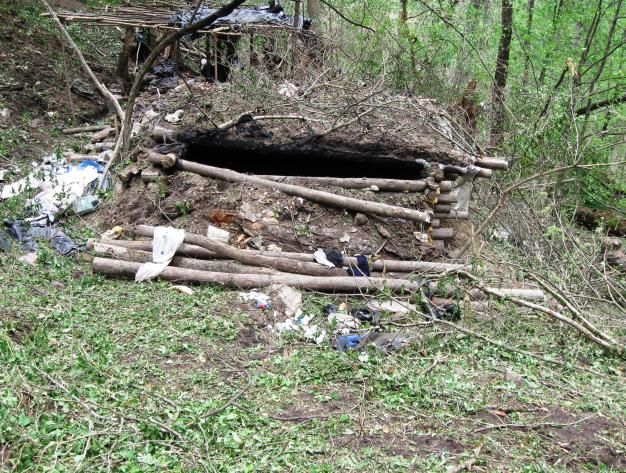
How to live now? Where to go? Where to go? How much goodness has been lost!
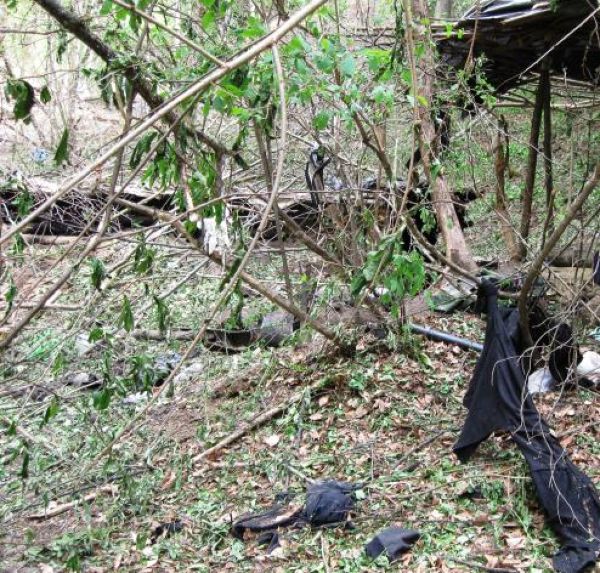
In short, the discovery of a base is a good reason for sadness... Therefore, you have to leave the bases for the spring-summer-autumn and wander through the mountains, stopping for the night wherever necessary. Sometimes it looks relatively civilized from the point of view of, for example, a tourist:
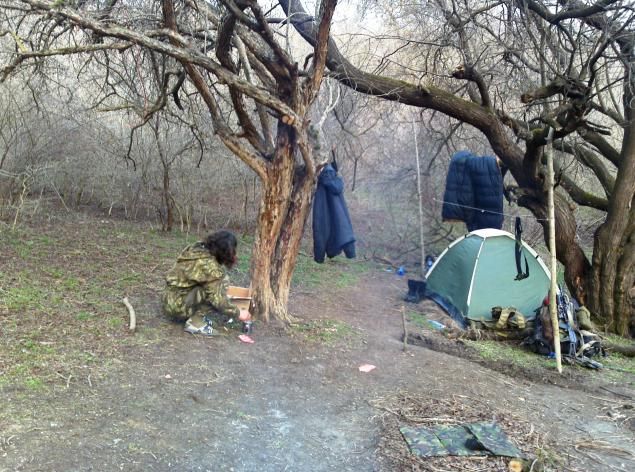
But most often it’s like a dog. Fell on the rug and slept:
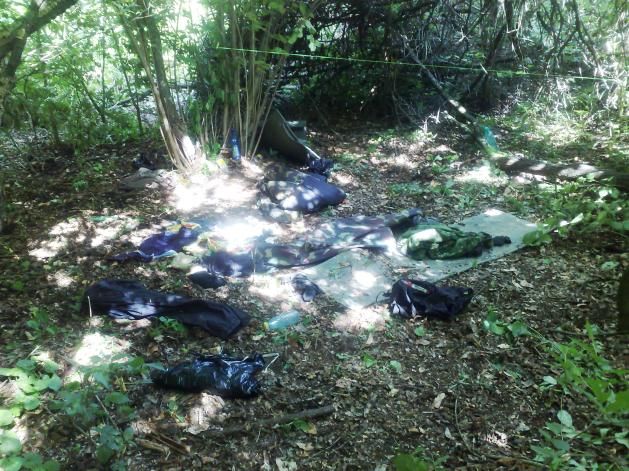
Here, to the question of debate about whether bandits burn fires. Disguise and so on. On a burner, for example, how many people can you cook for? How long will you last in dry food? You have to take risks and build fires.
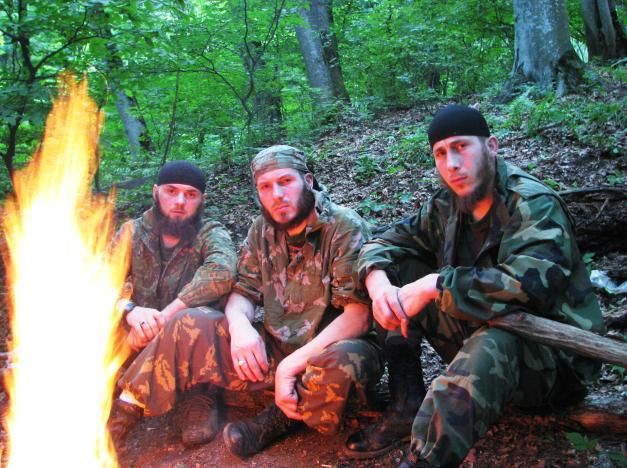
Sometimes they even make original ovens. Bake bread (the food trucks don’t come to them). To prevent the heat from going to waste, long johns are dried over the cakes.
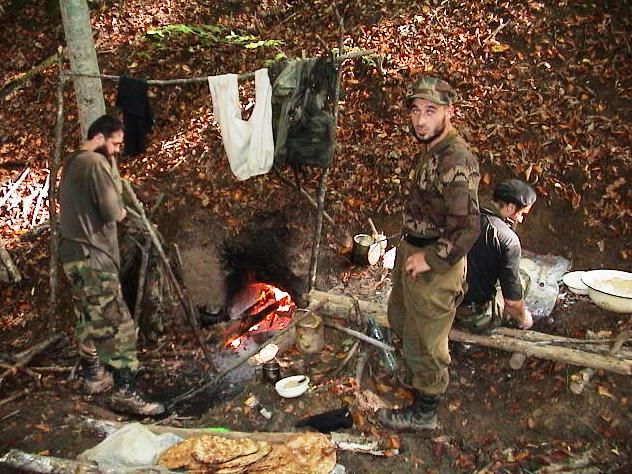
A fire is needed not only to dry off and warm up, but also to prepare some kind of hot stew:
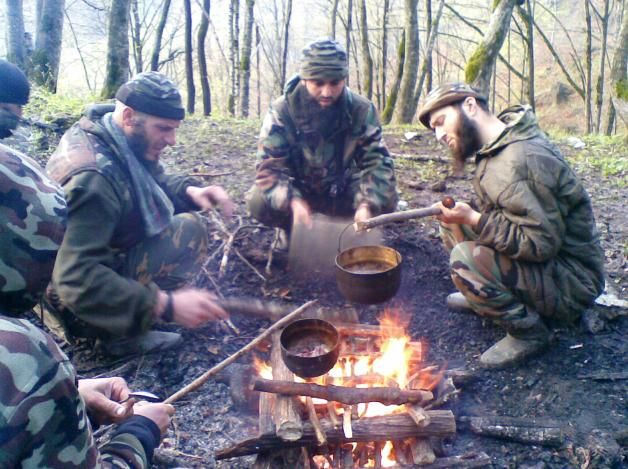
But sometimes there is practically nothing to cook with. They will accept an accomplice who supplied food and everything - on a starvation diet. We have to return to the primitive communal system - gathering, fishing and hunting. I caught some fish and sipped my fish soup:
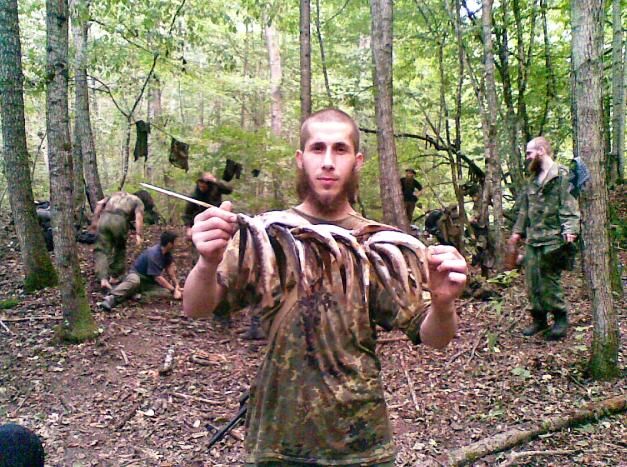
And if you managed to shoot game or bring down a lamb, then this is already a holiday. The remaining meat needs to be dried, otherwise it will start getting worms.
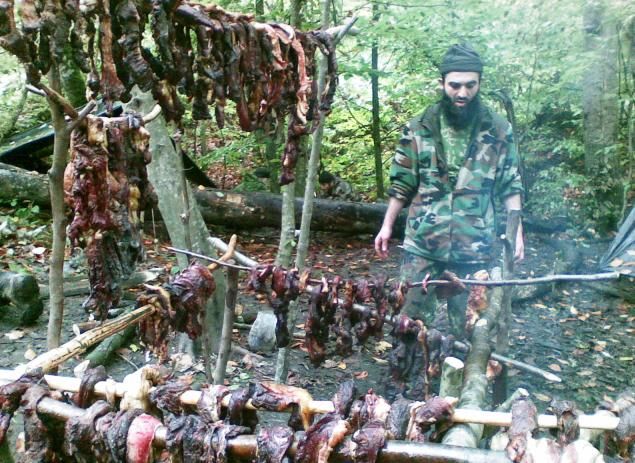
Once upon a time, during drying, they were dropped from a helicopter. We were not in the know, and when we arrived, we found pieces of meat on the branches around. At first they thought it was the bandits who were so torn apart. Meh... Again, about hygiene - this is how they prepare their food:
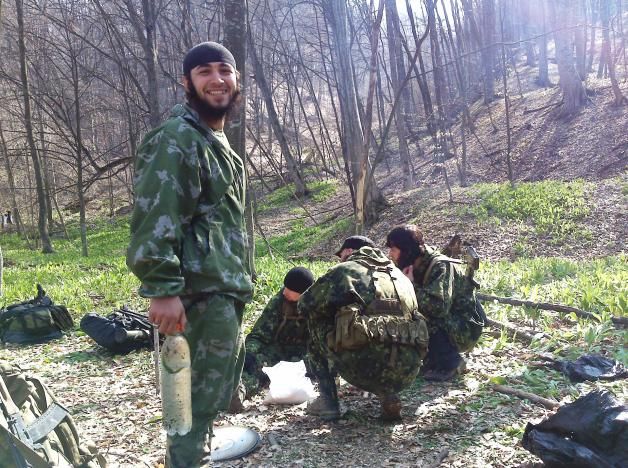
The bottle is okay, but look at the pot in which they cook:
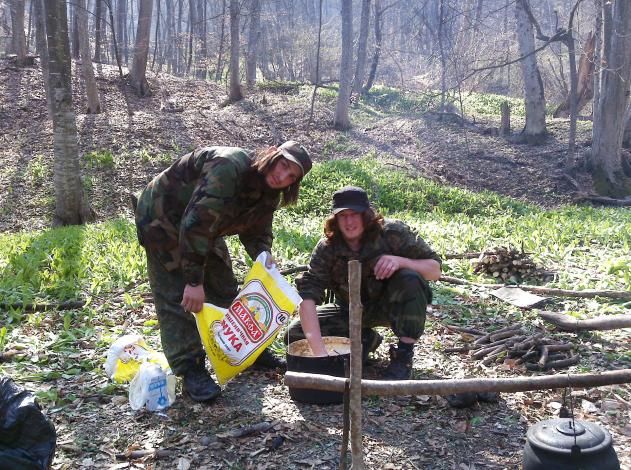
Do you see how crystal clean the cooks’ hands are? No? Well, no, look here:
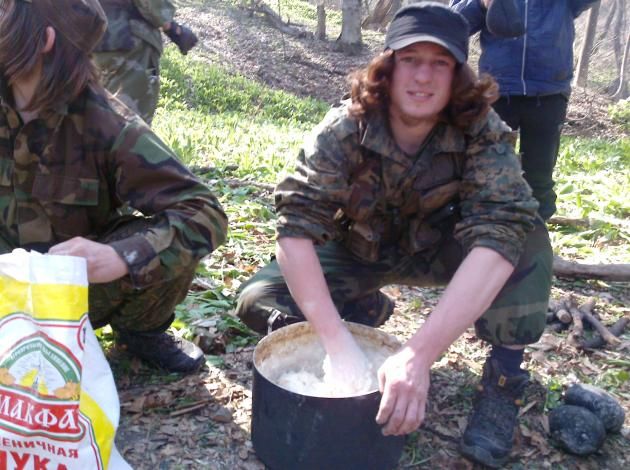
But there will be hot stew. More often you have to eat dry food - what you have:

In fact, it is everyday life that keeps many potential militants from going into the forest. Most often, accomplices leave when they realize that they can come for them at any moment. There is not much choice here - prison or hole. The Imaraty people understand this. And somehow they even decided to film a commercial showing them feasting. Like, we don’t need anything, we live like kings. Alas, the idea ended badly. A few days later, both the one who filmed and those who were filming ended their worthless existence. Well, at least they ate it humanely for the last time.
